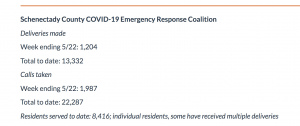Schenectady’s Responses to the COVID-19 Pandemic
Image from Schenectady County home page
In terms of community health, Schenectady created the Schenectady County COVID-19 Emergency Response Coalition to respond to the COVID-19 pandemic. The coalition brought together the Schenectady foundation, the Boys and Girls Club and other local foundations to address the non-medical coronavirus-related needs of the community. The main focus of the coalition was to deliver groceries and other essentials, while also identifying services offered by partner organizations for those with additional needs: child care, legal aid etc. A hotline was created so that residents could reach out with questions whenever they needed: 518-621-3536. Residents in need of groceries or other essential items could call the number and they scheduled a drop off time for the resident. If residents were in need of greater services such as temporary housing or financial aid, the coalition stated, “Representatives from the County Department of Social Services will also be on hand to assist with shelter, temporary assistance programs and Medicaid issues. Staff will also have information about resources available to address other identified needs” (Schenectady County). This seems to have been a huge success and asset to the community. Just two months into the pandemic the coalition took over 22,000 calls, made 13,000 deliveries and helped over 8,000 residents.
Emergency Response Coalition Numbers
Ellis hospital, the local hospital in downtown Schenectady remained open and provided medical services to individuals in need. They posted a resources page on their website in which they provided information on how to have proper hand hygiene, how to access their testing site and important links and phone numbers. Schenectady also provided a couple of additional testing sites around the city in order to help limit the spread of the virus.
Union College members also make up a large part of the Schenectady community and as a whole responded promptly to the pandemic. Students and faculty were sent home immediately and those who contracted the virus were placed in quarantine until safe to return to the community. The college did a great job communicating with students and faculty and transitioned smoothly to online classes. When it was time for students to return to school they made sure to test all students before entering the community in order to prevent an outbreak in the area. Students then got tested once a week from then on. The college updates a COVID-19 dashboard daily so members are able to follow any developments in cases.
COVID-19 Dashboard Union College
Overall, community members were provided with many resources and reminded that they were not alone during the difficult time.
Sources:
Emergency Coalition- https://www.schenectadycounty.com/content/schenectady-county-covid-19-emergency-response-coalition-launched
Union College- https://www.union.edu/where-you-are/covid-19-dashboard
Ellis Hopsital- http://www.ellismedicine.org/covid19/public.aspx










